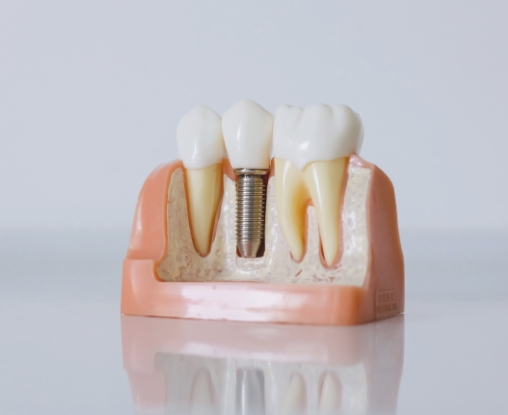Implantology Leiden
What is an implant?
When are implants used?
- If one tooth is missing, an implant is placed in the jaw to replace the missing element, after which a crown is attached.
- In the absence of multiple teeth or molars, two or more implants are placed on which a fixed bridge is attached. This bridge replaces the missing teeth or molars.
- In the absence of all teeth, two or more implants are placed. Buttons or rods are placed on these implants, on which a covering prosthesis clicks. This prosthesis is removable, but is more secure than a regular denture. In some cases, a non-removable bridge can be placed, but this requires at least four implants and makes the treatment more expensive, because insurance often does not cover such treatments.

Who places the implants and fits the prosthetic device?
Implants can be placed by a dentist with specialist knowledge in implantology, a dental implantologist or a maxillofacial surgeon. In our practice, a NVOI recognized dentist-implantologist working.
The crown or bridge on the implants is made by your own dentist or dental implantologist, in collaboration with a dental laboratory. In the case of a click prosthesis, the treatment can be carried out by a dentist or a dental prosthetist, a specialist who is trained in making dentures.
When is treatment with implants possible?
In principle, anyone with a fully grown jaw bone (from approximately 21 years of age) can have implants placed, provided that a number of conditions are met:
- There must be sufficient jawbone in both height and width.
- The jaw bone must be healthy.
- The gums of the remaining teeth should also be healthy. If not, they should be treated first.
- The facilities provided must be properly maintained.

How does the treatment with implants proceed?
Placing an implant is done in several steps and is always done under anesthesia. Below you can see exactly what you can expect during the treatment.
- Administration of the anesthetic: The dentist will start by administering a local anesthetic around the area where the implant will be placed. This will prevent you from feeling any pain during the treatment.
- Opening the gums If the anesthesia works well, the gums are carefully opened. This is done with a small incision, so that the jawbone underneath becomes clearly visible.
- Drilling into the jawbone At the place where the implant is to be placed, the dentist drills a small hole in the jawbone with a special drill. This is done very precisely.
- Placing the implant The implant, which is usually made of titanium, is then screwed firmly into the drilled hole. This forms the basis for the future tooth or molar.
- Suturing of the gums Finally, the gums are neatly stitched over or around the implant. The wound can then heal well and the implant can grow into the bone.
After the treatment, the dentist will give you instructions for proper healing. With the right care, you will lay the foundation for a strong and durable end result.
After insertion of the implants
After the implants are placed, pain and swelling may occur at the treated area. If necessary, the practitioner can prescribe painkillers. It is also advisable not to eat very hard food for one or two weeks.
The implant may not be subjected to excessive loads during the first few months after placement. If necessary, a temporary provision will provide the necessary chewing function and aesthetics. Two to six months after the procedure, the implants will have grown firmly into the bone, after which the dentist or dental technician can make the crown, bridge or prosthesis.

Oral hygiene with implants
Aftercare for implants
Cost of implants
Frequently asked questions about implantology
The costs of an implant treatment vary depending on the treatment and the health insurance. Treatments for a capping prosthesis in the lower jaw are often (almost) fully reimbursed by the insurance. For other treatments, such as a crown or bridge on implants, there is often little to no reimbursement, which means that the costs are almost entirely at your own expense. It is advisable to request an estimate in advance and to consult with the insurer to avoid surprises.
What exactly is a dental implant?
A dental implant is an artificial root made of titanium that is placed in the jawbone. It serves as a solid base for a crown, bridge or click denture. It feels and functions like a natural tooth root.
Does it hurt to have an implant placed?
No, usually not. The treatment is done under local anesthesia, so you won't feel anything. After the procedure you may experience some pain or swelling, but this can usually be remedied with painkillers.
How long does it take for an implant to become fixed?
On average, it takes 8 to 12 weeks for the implant to grow properly into the jawbone. This healing period is also called 'osseointegration'.
Can anyone get an implant?
Not everyone is immediately eligible. There must be sufficient jawbone and your oral health must be good. Smoking or certain diseases can reduce the chance of success.
How long does an implant last?
An implant can last for decades, sometimes even a lifetime. Good oral hygiene and regular check-ups at the dentist are essential for its preservation.


